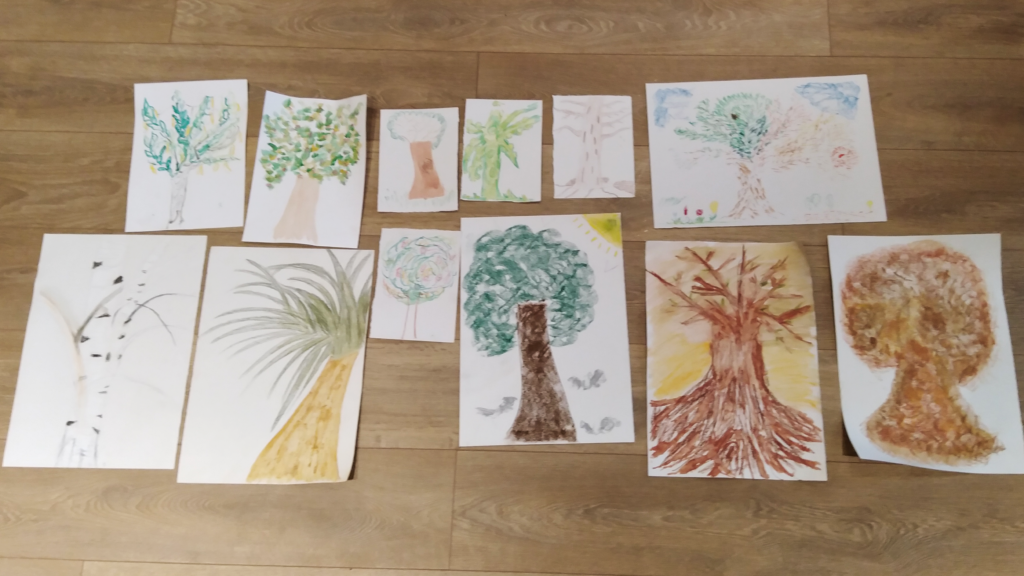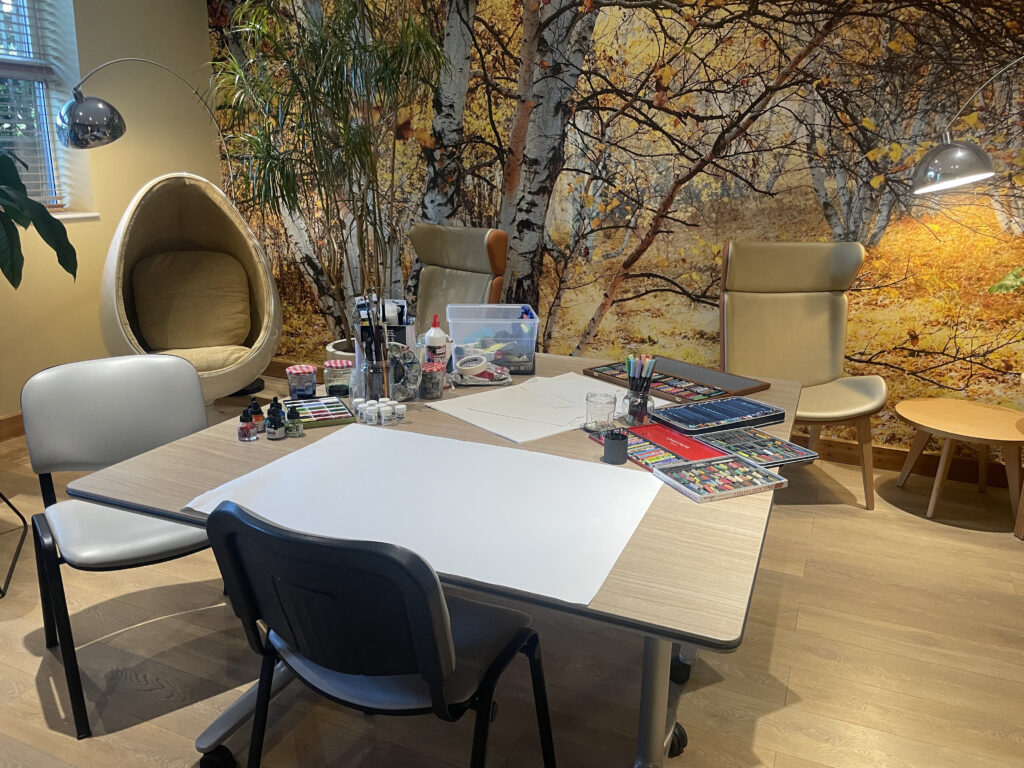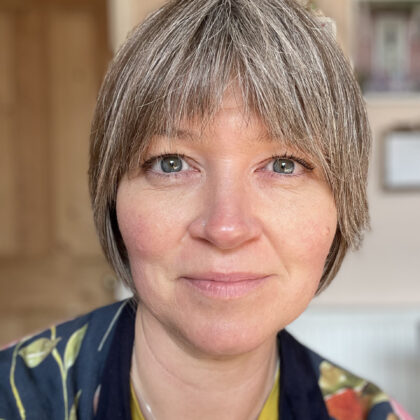Working as an art therapist in an adult hospice
Spotlight
Spotlight is our regular series dedicated to shedding light on the roles of art therapists within different contexts. In this article, Hannah Cridford tells us about her work as an art therapist in hospices.

Who are you?
I have been an HCPC-registered art therapist for over ten years now. I trained part-time at Goldsmiths College in London. During my training I worked in community arts in health and education settings.
Prior to this, I was a glassmaker working first in Scotland and then in the West Midlands, where I also gained experience of supporting disabled adults, and working with families affected by domestic abuse and children impacted by bullying, all utilising community arts activity.
I had experienced how helpful the arts could be in supporting people with wellbeing and social connection, but I often had a sense that something more was just out of reach, which I didn’t know how to safely bring to the surface. Art psychotherapy felt like the next natural step.
I am now based in the West Midlands, where I am a parent to three children and work in two part-time jobs as an art psychotherapist.
Where I work as an art therapist
One of my roles as an art therapist is in an adult hospice, where I have been employed for seven years. I am part of the counselling and support team, offering psychological support to patients who are thought to be in the last year of their life, and their families during pre-bereavement and bereavement.
We have a range of provision, including peer support groups, a volunteer ‘bereavement listening’ service, and specialist counselling and psychotherapy on an individual and group basis. At the moment, I am the only art psychotherapist in the team.
Getting here
Before training I had experiences in hospice environments that were important for me personally, and which fuelled my commitment to training in art psychotherapy. I was fortunate in being awarded The Corinne Burton Scholarship at Goldsmiths, which supported me financially and developmentally. The Corinne Burton Memorial Trust is a charity furthering the practice of art psychotherapy for cancer care and has contributed enormously to the development of this area of work in the UK over four decades.
The scholarship includes a ‘stipend’ following qualification, which funds up to two years of part-time clinical placement at an institution working with cancer patients. Through this, I was able to pilot a range of art therapy services at the hospice, leading to the development of a permanent, part-time post.

A typical day at work in a hospice
As one of the priorities for the hospice is to ensure that services are as accessible as possible, my one day working for the hospice is in two locations. I begin in a residential building in an estate on the outskirts of the city, where we house the counselling service. From here, I undertake initial assessments for people referred into our service, usually over the telephone, and offer individual art psychotherapy sessions in person.
In the afternoon, I head over to the main hospice site, a 19th century manor house which houses an 18-room inpatient unit, outpatient clinics and administrative offices. Set in large, landscaped grounds, we also have a charity shop, a café and peaceful remembrance gardens, all open to the public. Here, I provide art psychotherapy sessions for bereaved children who need a service after school hours. I am also able to visit patients on the inpatient unit and deliver group interventions.
Extraordinary things take place in hospices; they are full of life, warmth, and connection. I am often deeply moved in my work.
At present, I mostly work with people in individual art psychotherapy sessions. I understand the current necessity for individual therapy as a reflection of the complexity of needs with which people are referred to me. Although illness or bereavement are what brings someone into therapy, the work often leads us into historic or unresolved challenges from other aspects of their life.
I also offer one-off group sessions as part of a wider programme of bereavement support and for staff wellbeing. For these, I facilitate engagement for people who may not feel confident in working creatively, guiding introductory exercises in mark-making and/or offering themes, which can help anchor participants in the process.
When someone from the inpatient unit is referred to art therapy, I attend the handover meeting at the start of the day and/or the weekly multidisciplinary meeting. These meetings offer helpful opportunities to think collaboratively about some of the most complex life experiences of our patients and families, to offer a psychological perspective to the team and to connect with my colleagues.
What I love about what I do
Extraordinary things take place in hospices: they are full of life, warmth and connection. I am often deeply moved in my work; I feel privileged to witness the adaptability and resilience of people in some of the most difficult, yet unavoidable, human experiences.
I love that I get to work with adults and children, and I really enjoy working within a multidisciplinary team that is so varied – medics, nurses, psychologists, counsellors, physiotherapists, occupational therapists, complementary therapists, spiritual care professionals and volunteers. This range of perspectives and professional knowledge enriches all our experiences in providing holistic, individualised care for each person.
I love that I get to work with adults and children, and I really enjoy working within a multi-disciplinary team that is so varied
How I look after myself in my role
Connecting with other art therapists is one of the main ways I take care of myself in this role. I am on the voluntary organising committee for The Creative Response: Art Therapists Working with Loss special interest group at the British Association of Art Therapists, and we meet regularly to develop a programme of opportunities for our members. As a solo art therapist, I value the shared language and experiences of colleagues on the committee and in our wider special interest group membership. I often feel sustained by this network.
Outside of work, I run regularly; I enjoy being outside in all weathers and moving at my own pace. I also spend time on my allotment where I am learning a lot. I know very little about gardening and I am constantly amazed by the possibility of successfully growing something I can eat!
Working with people at the end of their lives and in bereavement offers insight and perspective on your own life. I spend time with my family, which this role helps me recognise as precious.
Hospice care was built on a model of ‘total pain’, outlining four realms of distress that can present at the end of life: physical, spiritual, psychological and social. Art psychotherapy has something to offer in all these areas.
What I wish I had known when I started
I wish I had known that working in hospice settings would include such a wide range of approaches and client groups. The universality of experiencing bereavement and the end of life means that you encounter people with varying histories and complexities. I have been able to continue to work with both children and adults, with people with pre-existing mental health or learning needs, and those without.
A recent development for the sector has been a more widespread uptake of trauma-informed approaches, which unites two areas of special interest for me and is a really important area of development.
Moving forward
Hospice care was built on a model of ‘total pain’, outlining four realms of distress that can present at the end of life: physical, spiritual, psychological and social. Art psychotherapy has something to offer in all these areas, attending to and alleviating distress and pain of all kinds for patients and their families.
At the moment, hospice charities are experiencing a widespread funding crisis, leading to reduced services and redundancies. Thanks to colleagues past and present, the work of art psychotherapy continues to gain recognition as a crucial contribution, even in this context of change and challenge for the sector.
Art therapy in hospices

Article note: while the article was written when Hannah was in post at Compton Care, she has since left the post and continues to work as an art psychotherapist in other roles. Compton Care continues to provide art therapy, with a new art therapist appointed to the role.
